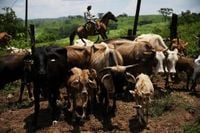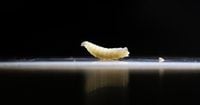On Friday, August 15, 2025, Texas Governor Greg Abbott and U.S. Secretary of Agriculture Brooke Rollins stood shoulder to shoulder in Austin, sounding the alarm and unveiling an ambitious, multi-pronged plan to defend the state—and the nation—against a looming threat: the resurgence of the New World screwworm. This flesh-eating pest, infamous for its devastating impact on livestock and wildlife, has crept perilously close to the U.S. border, prompting urgent action and a record-setting investment of nearly $900 million to stave off disaster.
The New World screwworm, a parasitic fly native to Cuba, Haiti, the Dominican Republic, and parts of South America, is no stranger to Texas. According to the U.S. Department of Agriculture (USDA), the larvae of this fly burrow into the fresh wounds of living animals—cattle, deer, pets, and occasionally even people—feeding on their flesh and often causing deadly infections. The state’s ranchers and wildlife managers still recall the devastation wrought by a screwworm outbreak in the 1960s, when an estimated 80% of Texas’s white-tailed deer perished, and the cattle industry suffered enormous losses.
Now, as the pest reemerges in northern Mexico, the stakes are once again sky-high. "This is an enormous challenge and you need to understand the magnitude," Governor Abbott declared at the press conference, as reported by NewsNation. "Just in Texas, this can result in billions of dollars of losses a year." His warning was echoed by U.S. Sen. John Cornyn, who told colleagues, "A case of the New World screwworm was reported less than 400 miles south of the U.S.-Mexico border. It may soon come across the border and lead to an outbreak in our state."
In response, the federal government and Texas officials are mobilizing resources on an unprecedented scale. Secretary Rollins announced that the USDA will spend up to $750 million to build a state-of-the-art sterile fly production facility in Edinburg, Texas. This facility, when completed, will churn out 300 million sterile screwworm flies each week—an essential weapon in the battle to suppress wild populations by disrupting their reproduction. The plant will be co-located with a previously announced sterile fly dispersal center at Moore Air Base, and will work in tandem with a similar facility in Panama, which already breeds up to 100 million sterile flies per week. Rollins emphasized the urgency, noting, "All Americans should be concerned."
The sterile fly technique, developed in the mid-20th century by University of Texas entomologists Edward F. Knipling and Raymond C. Bushland, was instrumental in eradicating screwworms from the U.S. decades ago. The method involves releasing vast numbers of sterile male flies into the wild, where they mate with females, resulting in eggs that never hatch. This approach dramatically reduces the pest population over time. According to KXAN, the USDA estimates that as many as 500 million sterile flies must be released weekly to push screwworm populations back south in Latin America and keep them from crossing into the U.S.
But the fight doesn’t end with sterile flies. Secretary Rollins also announced an additional $100 million investment in new technologies to combat screwworms, as well as funding to hire more mounted officers to patrol the border and monitor for signs of infested wildlife. Imports of Mexican cattle were suspended in July 2025, a move that further squeezed already tight U.S. cattle supplies, but officials insist the ports won’t reopen "until we begin to push the screwworm back," as Rollins put it during the Reuters briefing.
“Proactive measures like this dispersal facility are a critical step to ensure our state and nation are prepared to respond swiftly and effectively to this challenge. We will continue to work with our federal partners to eliminate this threat,” Governor Abbott told reporters, as quoted by Vax Before Travel. The USDA is also collaborating closely with Mexico, investing in a sterile fly production plant there, set to open in 2026, and sharing data to track the movement of the pest.
The economic stakes are staggering. Peyton Schuman, senior director of government relations for the Texas and Southwestern Cattle Raisers Association, estimated that a screwworm outbreak could cost Texas approximately $1.8 billion per year in livestock damages alone. And that’s just the tip of the iceberg. The state’s hunting industry, which depends heavily on healthy deer populations, could face similar devastation. During the 1960s outbreak, the loss of white-tailed deer was catastrophic, and experts fear a repeat if the pest gains a foothold.
Recognizing the threat, Governor Abbott established the Texas New World Screwworm Response Team earlier this year, tasking it with coordinating surveillance, response, and public education efforts. The CDC and USDA have both confirmed the detection of New World screwworm in northern Mexico, and the USDA has already launched an $8.5 million sterile fly dispersal facility in South Texas as an early line of defense.
For ranchers and wildlife managers, vigilance is the order of the day. The telltale signs of infestation—foul-smelling wounds crawling with maggots, animals persistently licking or biting at their injuries, lesions in bellybuttons, ears, or branding sites, and unexplained lethargy—are now burned into the minds of those on the front lines. The Texas A&M Agrilife Extension office urges anyone suspecting an infestation to immediately contact authorities such as the Texas Animal Health Commission or Texas Parks and Wildlife, and to notify their veterinarian. Early detection and reporting are critical, as is the collection of samples for confirmation.
While topical treatments are available for affected animals, prevention remains the ultimate goal. Notably, as of 2025, there are no FDA-approved vaccines for New World screwworm in humans, though a promising cattle vaccine is in development. This leaves the sterile fly program as the primary defense, supported by border surveillance and rapid response teams.
Despite the daunting challenge, there is cautious optimism among experts and officials. The U.S. successfully eradicated screwworm in the 20th century using similar methods, and the scientific community has decades of experience to draw upon. However, as Larry Gilbert, a professor at UT Austin and director of the Brackenridge Field Lab, cautioned, wild deer populations remain particularly vulnerable: “The deer herds would be very vulnerable to this, and you don’t go around treating wounds on deer. It’s hard to find them.”
With the border closed to Mexican cattle, hundreds of millions of dollars pouring into new facilities, and a renewed sense of urgency among federal and state agencies, Texas is mounting a robust defense against a tiny but formidable adversary. The coming months will test the resolve and ingenuity of scientists, ranchers, and policymakers alike as they race to keep the screwworm at bay—and protect the backbone of Texas’s economy and rural way of life.
For now, the message from Austin is clear: vigilance, innovation, and cooperation are the best weapons against a pest that, left unchecked, could rewrite the story of Texas agriculture for years to come.





